Snakes are probably the most infamous animal on earth. They’re the perfect blend of weird, frightening, and beautiful, and this must be why seemingly every culture on the planet has one or more legends about them.
Snakes are tetrapods (four-legs) with no legs. That alone makes them pretty outstanding. They’re also strangely elongated; no other vertebrate animal has proportions quite like them.
While elongations in the giraffe world are a product of larger bones, in snakes, it’s a result of many more of them. Thanks to a gene that allows a lot more ribs to be produced during their development as embryos, snakes come out all stretched and long.
There are numerous claims about how large they can grow, and myth and film frequently depict them as monster-like in length. But what is the biggest snake in the world? Let’s find out!
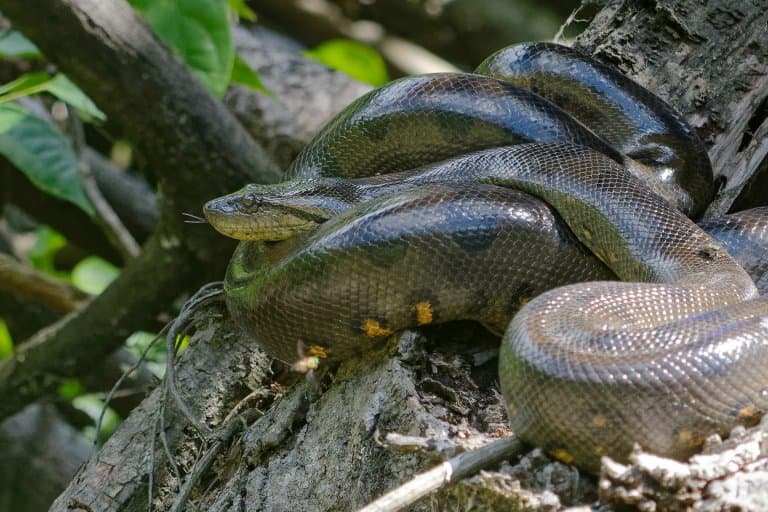
The Longest Snake
We’ll break these up into three categories because each one has a different answer. Here are the longest snakes on land, in water, and with a nasty bite.
Reticulated Python (Length: 7.67m / 25.2ft)
The largest snake is a colossal constrictor found in South-East Asia. The reticulated python, Python reticulatus has an average length of around 5-7 meters (around 20ft) but it is known to reach lengths of up to 7.67 meters (25’2’), as is the case in the longest ever reliably measured. 1
The Guiness World Records has a specimen shot in Celebes, Indonesia in 1912 as the longest snake ever recorded. It measured 10m (32ft), but there is little evidence to back this up considering the date. 2
There have been other claims of much larger specimens as well. In 2003, a zoo in Curugsewu, central Java, claimed to have a reticulated python that measured 14.85m (49ft) long with a body circumference of 85cm (almost three feet) and weighing 447kg (70 stone, 3lbs). However, like many claims, this hasn’t been verified. 3
In the wild, these animals are doing quite well on a species level, despite being hunted for the pet trade and in traditional medicine. They’re non-venomous, but they’re big enough to eat a small person, and have, in fact, done so. 4
Still, even a small person is quite a mouthful for the longest snake in the world, and the main reason the two individuals would ever bother one another is likely the overlap of the two habitats as more rainforest is being cut down.
The Longest Sea Snake
Yellow Sea Snake (Length: 3m / 9.8ft)
This slender, aquatic snake is venomous, and commonly averages about 1.83 meters (6ft) long. However, it’s been recorded up to around three meters, making it the longest-recorded sea snake.
This is a very vivid, green or yellow snake with striking black bands, and like most sea snakes, it has potent venom. They’re well adapted to the ocean environment with a paddle-shaped tail and the likely ability to respire through the skin on their backs. 5 6
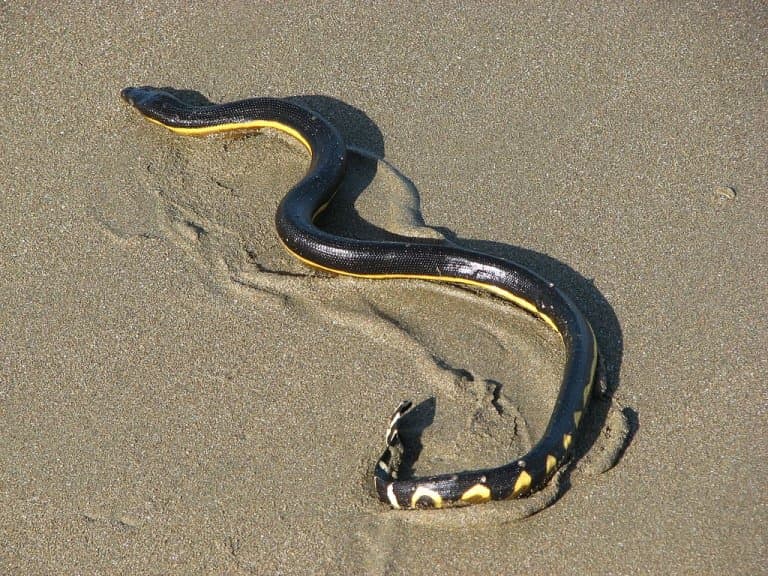
The Longest Venomous Snake
King Cobra (Length: 5.59m / 18.3ft)
Another contender from South and Southeast Asia is the King Cobra. This exceptionally long animal is slender and fast, and well known for its hood display that should only be seen in extreme cases. Generally, this highly-venomous snake is timid and will avoid people.
These snakes commonly reach 3 meters long, but have been documented up to 5.59m in India. These, too, are threatened by habitat destruction, and are now listed as vulnerable by the IUCN. 7 8
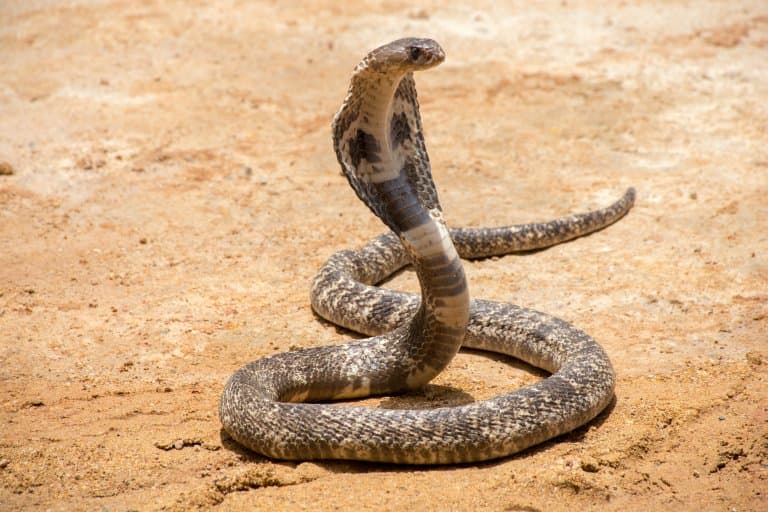
The Heaviest Snake
It might come as a surprise that the longest snakes aren’t always the same ones as the heaviest. While some seem to have gone for extended length, others went for girth, and either strategy has its advantages.
Here’s a look at the heaviest snakes in the world.
Green Anaconda (Weight: 97.5kg / 216 lb)
This is a similar animal to the reticulated python, in that it’s a nonvenomous constrictor that occupies more or less the same niche, just in a different place. The green anaconda is the heaviest snake ever recorded, though the heaviest example was never weighed.
Commonly reaching weights of around 97.5kg, and spends much of its time on the water to help with this. The largest ever recorded was not weighed, but was apparently significantly bigger than the heaviest recorded, and some estimates have it upwards of 227kg (500lb).
This snake was said to have reached an enormous 8.75 meters, but this doesn’t seem to be backed up with any evidence, yet. Regardless, this is a heavy animal, and like the reticulated python, has been said to occasionally swallow a person. 9 10

The Heaviest Sea Snake
Stoke’s Sea Snake (Weight: TBC)
This is the fattest and girthiest of all the sea snakes, as far as we can tell. It reaches up to about 2 meters long, and has a girth of 26cm, making it significantly chunkier than H. spiralis, and therefore likely a lot heavier.
Verified weights are hard to come by, but from the dimensions of the animal it’s clear that it’s a top contender for heaviest swimming snake (unless you count terrestrial snakes that spend time in water, like the anaconda).
They can dive for up to thirty minutes, and may live for up to 15 years. They’re often caught in prawn trawling nets, and are unlikely to be able to recover quickly, though currently are populous enough to be of least concern to the IUCN. 11 12
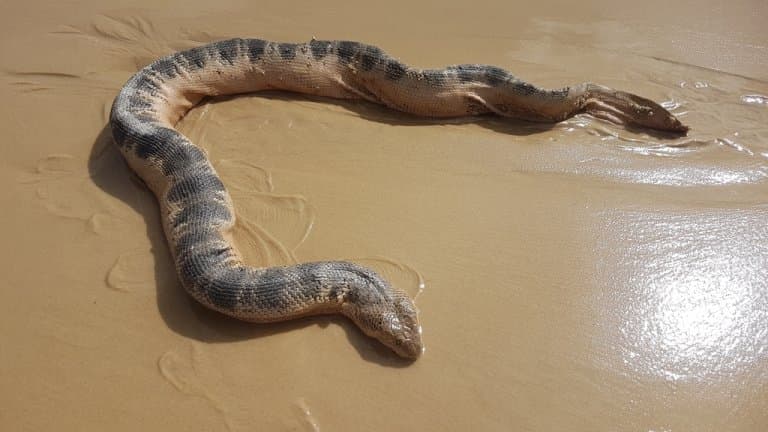
The Heaviest Venomous Snake
King Cobra (Weight: >10kg / 22lb)
As the longest venomous snake, it’s very likely this one is the heaviest, too. Specimens of up to 10kg have been reliably recorded, and despite there being fatter alternatives around, none of their weight records can be confirmed.
While the Diamondback Rattlesnake is the heaviest venomous snake in the US, it rarely reaches anything above 6kg, making it unlikely to topple the cobra. In this instance, the King wins again. 13
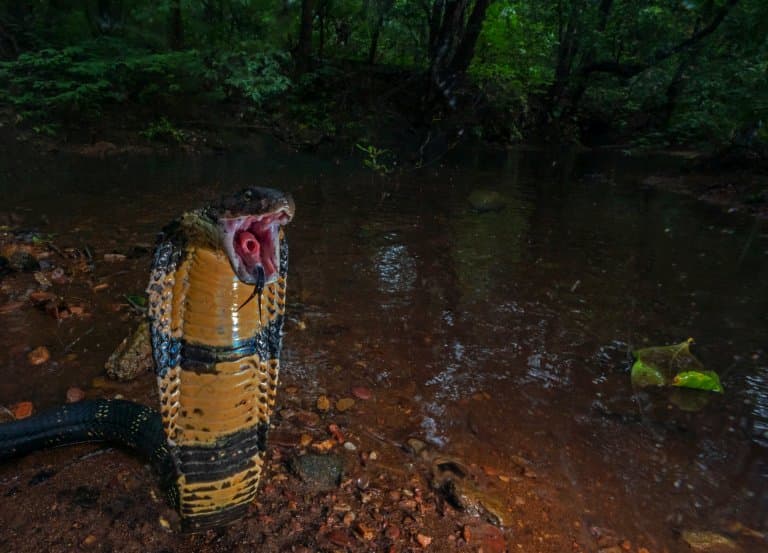
The Longest & Heaviest Snake Ever Existed
All of these monsters are modern, extant snakes that we can see in the wild. However, they’re not the biggest that ever existed. That accolade currently goes to the Titanoboa, T. cerrejonens.
Titanoboa Cerrejonensis (Length: 14.3m / 47ft. Weight: 1,135kg / 2,500lb)
Discovered in the fossil record as recently as 2009, this snake was as long as a sperm whale and likely weighed over 1100kg (2400lb). After the dinosaurs left, numerous animals vied for their newly-vacated niches. Some of them reaching enormous proportions.
This could have been the ancestor of modern anacondas, though it seems to have only existed for about 10-15 million years. 14
Final Thoughts
There has been lots of claims and reports of snakes reaching huge sizes, such as anacondas measuring over 9m (30 feet) in length, but very little credible evidence.
Almost all specimens in excess of 6m (20 ft), including a much publicised specimen of 11.36 m (37.3 ft) long are often just skin, without body or parts – and are prone to being stretched.
Our research includes the longest and heaviest snakes we could reliably and credibly verify from various sources.
Therefore reports of 40 foot long anacondas, like in the famous movie, are fictitious.
However, perhaps there are even larger specimens than those outlined above, hidden away in the depths of the jungle or under the water!
Fact Sources & References
- Guiness Editorial, “Longest snake in captivity ever“, Guinness World Records.
- Guiness Editorial, “Longest snake“, Guinness World Records.
- John Aglionby (2003), “Captured python said to be world’s biggest snake“, The Guardian.
- Kelsey Arp (2019), “On the Plate“, The Slate.
- Ruchira Somaweera (2009), “An overview of Sri Lankan sea snakes with an annotated checklist and a field key“, ResearchGate.
- Alessandro Palci et al (2019), “Novel vascular plexus in the head of a sea snake (Elapidae, Hydrophiinae) revealed by high-resolution computed tomography and histology“, National Library of Medicine.
- “Journal of the Bombay Natural History Society“, Bombay, Bombay Natural History Society.
- Stuart, B., Wogan, G., Grismer, L., Auliya, M., Inger, R.F., Lilley, R., Chan-Ard, T., Thy, N., Nguyen, T.Q., Srinivasulu, C. & Jelić (2011), “King Cobra“, The IUCN Red List.
- Damien Esquerre (2016), “Parallel selective pressures drive convergent diversification of phenotypes in pythons and boas“, Division of Evolution, Ecology and Genetics, Research School of Biology, The Australian National University, Canberra.
- Callum McKelvie, Jessie Szalay (2022), “Anaconda: Habits, hunting and diet“, Live Science.
- “Astrotia stokesii — Stokes’ Seasnake“, Department of Climate Change, Energy, the Environment and Water Australia.
- Sanders, K., White, M.-D., Courtney, T. & Lukoschek, V (2018), “Stokes’ Sea Snake“, The IUCN Red List.
- D. BRUCE MEANS (2009), “EFFECTS OF RATTLESNAKE ROUNDUPS ON THE EASTERN D IAMONDBACK R ATTLESNAKE (CROTALUS ADAMANTEUS)“, Herpetological Conservation and Biology.
- Huff Post Editorial (2012), “LOOK: Titanoboa, World’s Biggest Snake, Coming To Smithsonian“, Huffington Post.

